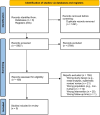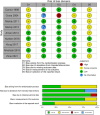The efficacy of adjunctive mitomycin C and/or anti-VEGF agents on glaucoma tube shunt drainage device surgeries: a systematic review
- PMID: 38656422
- PMCID: PMC11458658
- DOI: 10.1007/s00417-024-06476-z
The efficacy of adjunctive mitomycin C and/or anti-VEGF agents on glaucoma tube shunt drainage device surgeries: a systematic review
Abstract
Purpose: The effectiveness of mitomycin C (MMC) in trabeculectomy has long been established. The aim of this review is to evaluate the efficacy and safety of adjunctive agents in tube shunt drainage device surgery for glaucoma or ocular hypertension, since controversy still exists regarding their benefit.
Methods: We searched CENTRAL, PubMed, Embase, Web of Science, Scopus, and BASE for RCTs, which have used adjuvant antimetabolites-either MMC or 5-Fluorouracil (5-FU)-and/or anti-vascular endothelial growth factors (anti-VEGF) agents. The main outcome was IOP reduction at 12 months.
Results: Ten studies met our inclusion criteria. Nine used the Ahmed Glaucoma Valve (AGV) implant, while the double-plate Molteno implant was used in one study. Four studies used MMC. The remaining six studies used an anti-VEGF drug - either bevacizumab, ranibizumab or conbercept. Only one MMC-study reported a significant difference in the IOP reduction between groups at 12 months, favouring the MMC group (55% and 51%; p < 0.01). A significant difference was also reported by two out of five bevacizumab-studies, both favouring the bevacizumab group (55% and 51%, p < 0.05; 58% and 27%, p < 0.05), with the highest benefit seen in neovascular glaucoma cases, especially when panretinal photocoagulation (PRP) was also used. Neither ranibizumab nor conbercept were found to produce significant differences between groups regarding IOP reduction.
Conclusion: There is no high-quality evidence to support the use of MMC in tube shunt surgery. As for anti-VEGF agents, specifically bevacizumab, significant benefit seems to exist in neovascular glaucoma patients, especially if combined with PRP.
Keywords: Anti-vascular endothelial growth factor; Antimetabolites; Glaucoma; Glaucoma drainage implants; Mitomycin.
© 2024. The Author(s).
Conflict of interest statement
All authors hereby certify that there is not any actual or potential conflict of interest or unfair advantage, as they have no affiliations with or involvement in any organization or entity with any (non-)financial interest in the subject matter or material discussed in this manuscript.
Figures


Similar articles
-
Tube Shunt Revision With Excision of Fibrotic Capsule Using Mitomycin C With and Without Ologen-a Collagen Matrix Implant: A 3-Year Follow-up Study.J Glaucoma. 2019 Nov;28(11):989-996. doi: 10.1097/IJG.0000000000001371. J Glaucoma. 2019. PMID: 31567908
-
Evaluation the adjunctive use of combined bevacizumab and mitomycinc to trabeculectomy in management of recurrent pediatric glaucoma.Eye (Lond). 2016 Jan;30(1):53-8. doi: 10.1038/eye.2015.182. Epub 2015 Oct 2. Eye (Lond). 2016. PMID: 26427987 Free PMC article. Clinical Trial.
-
Review of results from the Tube Versus Trabeculectomy Study.Curr Opin Ophthalmol. 2010 Mar;21(2):123-8. doi: 10.1097/ICU.0b013e3283360b68. Curr Opin Ophthalmol. 2010. PMID: 20040872 Free PMC article. Review.
-
Efficacy of Adjunctive Subconjunctival Bevacizumab on the Outcomes of Primary Trabeculectomy With Mitomycin C: A Prospective Randomized Placebo-controlled Trial.J Glaucoma. 2015 Oct-Nov;24(8):600-6. doi: 10.1097/IJG.0000000000000194. J Glaucoma. 2015. PMID: 25393038 Free PMC article. Clinical Trial.
-
A review of neovascular glaucoma. Etiopathogenesis and treatment.Rom J Ophthalmol. 2021 Oct-Dec;65(4):315-329. doi: 10.22336/rjo.2021.66. Rom J Ophthalmol. 2021. PMID: 35087972 Free PMC article. Review.
Cited by
-
Anterior segment OCT for imaging PAUL® glaucoma implant patch grafts: a useful method for follow-up and risk management.Graefes Arch Clin Exp Ophthalmol. 2025 Apr;263(4):1071-1079. doi: 10.1007/s00417-024-06708-2. Epub 2024 Dec 16. Graefes Arch Clin Exp Ophthalmol. 2025. PMID: 39681685 Free PMC article.
-
Early safety and efficacy outcomes of the PAUL glaucoma implant in a Spanish population: A retrospective study.Saudi J Ophthalmol. 2024 Nov 18;38(4):368-373. doi: 10.4103/sjopt.sjopt_164_24. eCollection 2024 Oct-Dec. Saudi J Ophthalmol. 2024. PMID: 39943954 Free PMC article.
-
Fighting Bleb Fibrosis After Glaucoma Surgery: Updated Focus on Key Players and Novel Targets for Therapy.Int J Mol Sci. 2025 Mar 5;26(5):2327. doi: 10.3390/ijms26052327. Int J Mol Sci. 2025. PMID: 40076946 Free PMC article.
References
-
- Barbosa-Breda J, Gonçalves-Pinho M, Santos JV, Rocha-Sousa A, Abegão-Pinto L, Stalmans I, Freitas A (2018) Trends in Glaucoma Surgical Procedures in Portugal: A 16-Year Nationwide Study (2000–2015). J Glaucoma 27(8):682–686. 10.1097/IJG.0000000000001011 - PubMed
-
- Gedde SJ, Feuer WJ, Lim KS, Barton K, Goyal S, Ahmed IIK, Brandt JD (2020) Treatment Outcomes in the Primary Tube Versus Trabeculectomy study after 3 years of follow-up. Am J Ophthalmol 127(3):333–345. 10.1016/j.ophtha.2019.10.002 - PubMed
-
- Schwartz KS, Lee RK, Gedde SJ (2006) Glaucoma drainage implants: a critical comparison of types. Curr Opin Ophthalmol 17(2):181–189. 10.1097/01.icu.0000193080.55240.7e - PubMed
Publication types
MeSH terms
Substances
LinkOut - more resources
Full Text Sources
Medical
Research Materials
Miscellaneous

